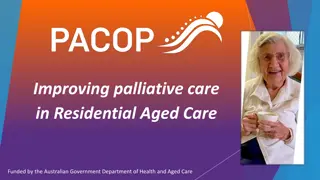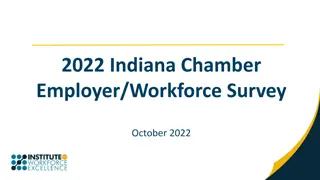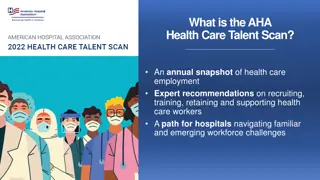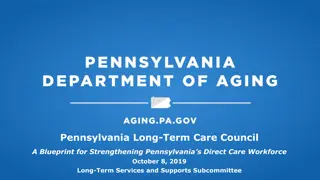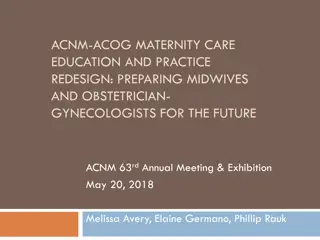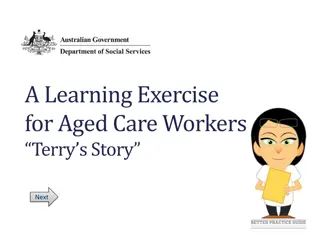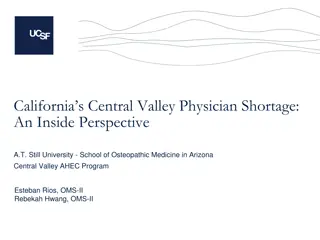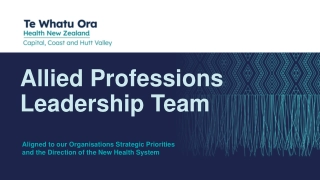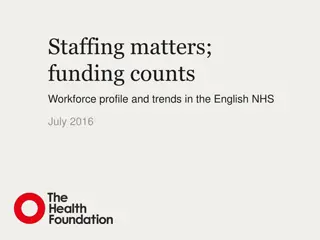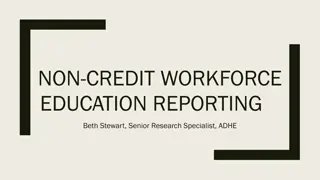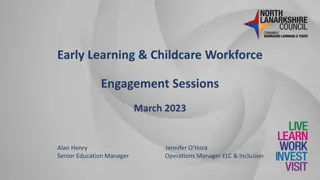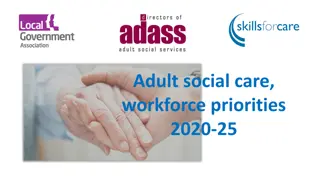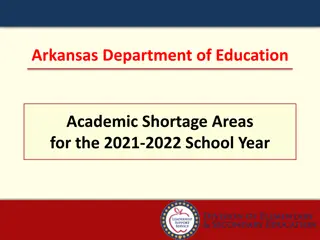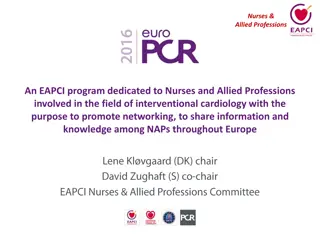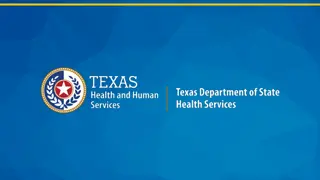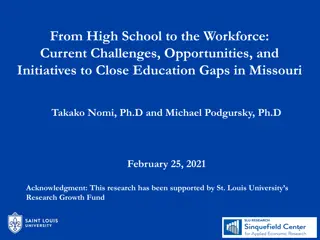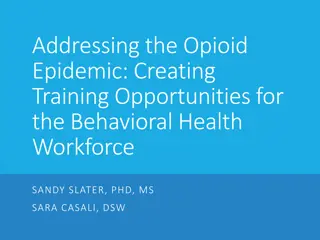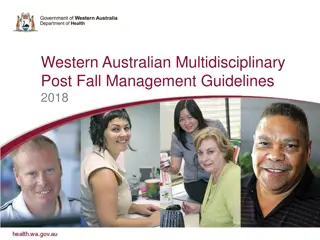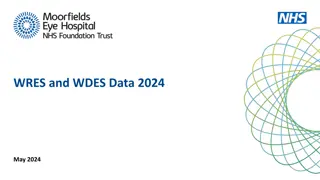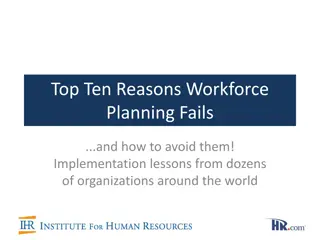Addressing Allied Health Workforce Shortage in Australian Aged Care
Estimated shortfall of 25,000 Allied Health Care workforce by 2033 in Australian aged care system according to a commissioned report. Increasing training places and graduates by 3.5x from current levels is necessary to bridge the gap. The total number of eligible aged care service recipients is expected to grow significantly by 2033, posing challenges in staffing. Presently, there are approximately 38,000 Allied Health Care professionals working in aged care. Discrepancies in pay and conditions vis-a-vis other sectors may contribute to staff shortages.
Download Presentation

Please find below an Image/Link to download the presentation.
The content on the website is provided AS IS for your information and personal use only. It may not be sold, licensed, or shared on other websites without obtaining consent from the author. Download presentation by click this link. If you encounter any issues during the download, it is possible that the publisher has removed the file from their server.
E N D
Presentation Transcript
Aged Care Allied Health Workforce Modelling Project A/Professor Jason Thompson The University of Melbourne, University Department of Rural Health, Transport, Health, Urban & Social Systems Research Group, Melbourne Centre for Data Science Professor Rod McClure Centre for Human Factors and Sociotechnical Systems, University of the Sunshine Coast Dr Pam Harvey Monash University Department of Rural Health Prof Lisa Bourke University Department of Rural Health, University of Melbourne Commissioned by: AUSTRALIAN COUNCIL OF DEANS OF HEALTH SCIENCES
Background Transport, Health, Social & Urban Systems Research Group University of Melbourne Melbourne Centre for Data Science Agent-Based Models and System Dynamics models of public health systems (infectious disease, TAC / WorkSafe / NDIS, etc.) University of The Sunshine Coast Centre for Socio-Technical Systems modelling University Department of Rural Health Monash University & Unimelb Health Decision Support Commissioned by: AUSTRALIAN COUNCIL OF DEANS OF HEALTH SCIENCES
Headline results To match international benchmarks of Allied Health Care support as set out in the Aged Care Royal Commission, the estimated shortfall in Allied Health Care workforce facing the Australian aged care system is approximately 25,000 by 2033. If anecdotal reports regarding differences in parity of pay and conditions between aged care and competing sectors are realistic, then such disparity is likely to be a major driver of allied health care staff shortages in aged care over time. To address this gap by 2030, the estimated increase in Allied Health Care training places and graduates in Australia would need to increase by 3.5x from current levels of an estimated 10,000 / year. Commissioned by: AUSTRALIAN COUNCIL OF DEANS OF HEALTH SCIENCES
The data The total number of people eligible for aged care services (those over 65 years and Aboriginal & Torres- Straight Islanders aged > 55 years) is expected to grow from approximately ~4.35m to ~5.65m between 2023 and 2033. Growth in the number of people becoming eligible for aged care services over time is currently accelerating and expected to peak in around 2029. There is no clear consensus on the number of allied health care professionals working in the three main areas of Commonwealth-funded aged care (residential care, Home Care Packages (HCP), and Commonwealth Home Care Support Packages (CHSP). Commissioned by: AUSTRALIAN COUNCIL OF DEANS OF HEALTH SCIENCES
The data Given the part-time work status of many employees, there are difficulties in estimating the true balance between headcount of allied health care staff and FTE staff / EFT it is acknowledged in many reports that some people are double-counted between systems. We estimate that the total estimated number of Allied Health Care professionals working in aged care at present is approximately 38,000. This compares to approximately 114k nursing staff and 239k certificate- qualified staff. We estimate that there are around 1.8 aged care staff employed for each FTE position (35 hours) across all professions in the sector, with approximately 2.3 Allied Health Care headcount employed per Allied Health Care FTE. Commissioned by: AUSTRALIAN COUNCIL OF DEANS OF HEALTH SCIENCES
The data There are currently no reliable data on the number of Allied Health practitioners in Australia. Australian Health Practitioner Regulation Agency (AHPRA) data is based on 16 Allied Health categories. No national data on non-AHPRA registered allied health practitioners is available. There are currently no reliable data on the number of Allied Health training places available in Australia nor current enrollments. We estimate the current available intake to be in the order of ~10,000 per year. The drivers of staff leaving the system are well documented and include discrepancies in parity of pay and conditions between sectors. The strength of factors driving allied health care professionals to and from sectors is uncertain. Commissioned by: AUSTRALIAN COUNCIL OF DEANS OF HEALTH SCIENCES
The model The model is a System-Dynamics model, built in a flexible, cloud-based platform. The model has been built to reflect the investigators current understanding of the aged care system. The model unfolds over a period of 10 years from 2023 to 2033. The model is not static and should be regarded as Version 1.0 . All parameters in the model are flexible and new versions of the model can be easily constructed in response to changing conditions or new / updated data, theory or other information. Commissioned by: AUSTRALIAN COUNCIL OF DEANS OF HEALTH SCIENCES
The model The model can be easily shared between users and contains a flexible dashboard highlighting headline measures of interest (see Figure 2 in report). The model is documented and contains a companion set of references and assumptions in an Excel table (see Appendix A) that should be kept updated for interpretation and transparency. The Appendix containing current model assumptions can be viewed here . A short video tutorial explaining the construction of the model and how it can be used is available here: https://vimeo.com/814131892#t=9 (it s low budget .) Commissioned by: AUSTRALIAN COUNCIL OF DEANS OF HEALTH SCIENCES
The model Commissioned by: AUSTRALIAN COUNCIL OF DEANS OF HEALTH SCIENCES
The model Aged People EFT Allocations Professions Estimated EFT across Allied Health care Commissioned by: AUSTRALIAN COUNCIL OF DEANS OF HEALTH SCIENCES
The model Commissioned by: AUSTRALIAN COUNCIL OF DEANS OF HEALTH SCIENCES
Appendices Appendix A contains a link to an Excel sheet where all model assumptions and formulae contained within the representation are detailed under the following headings: Item (the feature within the model) Feature type (stock, flow or variable) Initial Value (e.g., as of today ) Formula / Estimate Unit (e.g., time, headcount, FTE, hours) Reference Confidence (a rating as to how confident the modeling team is in relation to the data and/or estimate supplied), and Justification / Considerations (commentary on any issues associated with the data or estimates) Commissioned by: AUSTRALIAN COUNCIL OF DEANS OF HEALTH SCIENCES
Results To match international benchmarks of Allied Health Care support as set out in the Aged Care Royal Commission report of 22 minutes of Allied Health Care per day, the estimated shortfall in Allied Health Care workforce facing the Australian aged care system is approximately 25,000 people per year over the next 10 years. This result is affected by several key assumptions: There is a continued drain of Allied Care Professionals away from the Aged Care sector due to disparities in pay and conditions between the aged care sector and competing areas. That graduates trained in Allied Health will continue to work in aged care settings at current rates. That the growth in residential aged care places continues at 2% per annum. That current occupancy rates of aged care facilities will maintain levels of ~86%. That there will be no growth in HCP places. That there will be no growth in CHSP places. That the current ratio of Allied Health Care professional FTE to headcount will remain stable. That an increase of current levels of 8 minutes of Allied Health Care per resident in aged care facilities to 22 minutes is the desired standard (e.g., if there is no desired increase, there is no shortfall unless there is a max exodus from the sector). That the current mix of Allied Health Care professionals stays stable over time and that any changes affect each profession proportionately. These assumptions may or may not be realistic. However, regardless of their likelihood, the model enables the user to dial in these or alternative assumptions that to suit alternative scenarios. Commissioned by: AUSTRALIAN COUNCIL OF DEANS OF HEALTH SCIENCES
Results To match international benchmarks of Allied Health Care support as set out in the Aged Care Royal Commission report of 22 minutes of Allied Health Care per day, the estimated shortfall in Allied Health Care workforce facing the Australian aged care system is approximately 25,000 people per year over the next 10 years. This result is affected by several key assumptions: There is a continued drain of Allied Care Professionals away from the Aged Care sector due to disparities in pay and conditions between the aged care sector and competing areas. That graduates trained in Allied Health will continue to work in aged care settings at current rates. That the growth in residential aged care places continues at 2% per annum. That current occupancy rates of aged care facilities will maintain levels of ~86%. That there will be no growth in HCP places. That there will be no growth in CHSP places. That the current ratio of Allied Health Care professional FTE to headcount will remain stable. That an increase of current levels of 8 minutes of Allied Health Care per resident in aged care facilities to 22 minutes is the desired standard (e.g., if there is no desired increase, there is no shortfall unless there is a max exodus from the sector). That the current mix of Allied Health Care professionals stays stable over time and that any changes affect each profession proportionately. These assumptions may or may not be realistic. However, regardless of their likelihood, the model enables the user to dial in these or alternative assumptions that to suit alternative scenarios. Commissioned by: AUSTRALIAN COUNCIL OF DEANS OF HEALTH SCIENCES
Results To address this gap by 2030, the estimated increase in Allied Health Care training places and graduates in Australia would need to increase by 3.5x from current levels of approximately 10,000 / year. If anecdotal reports regarding differences in parity of pay and conditions between aged care and competing sectors are realistic, then such disparity is likely to be a major driver of allied health care staff shortages in aged care over time. All else being equal, preventing the current estimated drain of allied health care staff from working in aged care services by equalising pay and conditions between sectors could significantly reduce projected shortfalls in the allied health care workforce. Commissioned by: AUSTRALIAN COUNCIL OF DEANS OF HEALTH SCIENCES
Conclusions The Aged Care Allied Health Workforce Model developed in this project is based on a System Dynamics Framework and uses an accessible web-based platform. The model is based on several assumptions about workforce dynamics, aged care funding models and population statistics. The Aged Care Allied Health Workforce Model s parameters can be modifiable by the user, making it a flexible and responsive tool for Allied Health workforce planning. Its design allows for adjustments and updates to reflect changing circumstances and priorities. This flexibility enhances the model's usefulness in forecasting workforce needs and designing strategies to address them. Commissioned by: AUSTRALIAN COUNCIL OF DEANS OF HEALTH SCIENCES
New / Alternative Scenarios Growth in Aged Care places @ 5% p.a. Shortfall is ~35k at 10 years under the same assumptions. Commissioned by: AUSTRALIAN COUNCIL OF DEANS OF HEALTH SCIENCES


